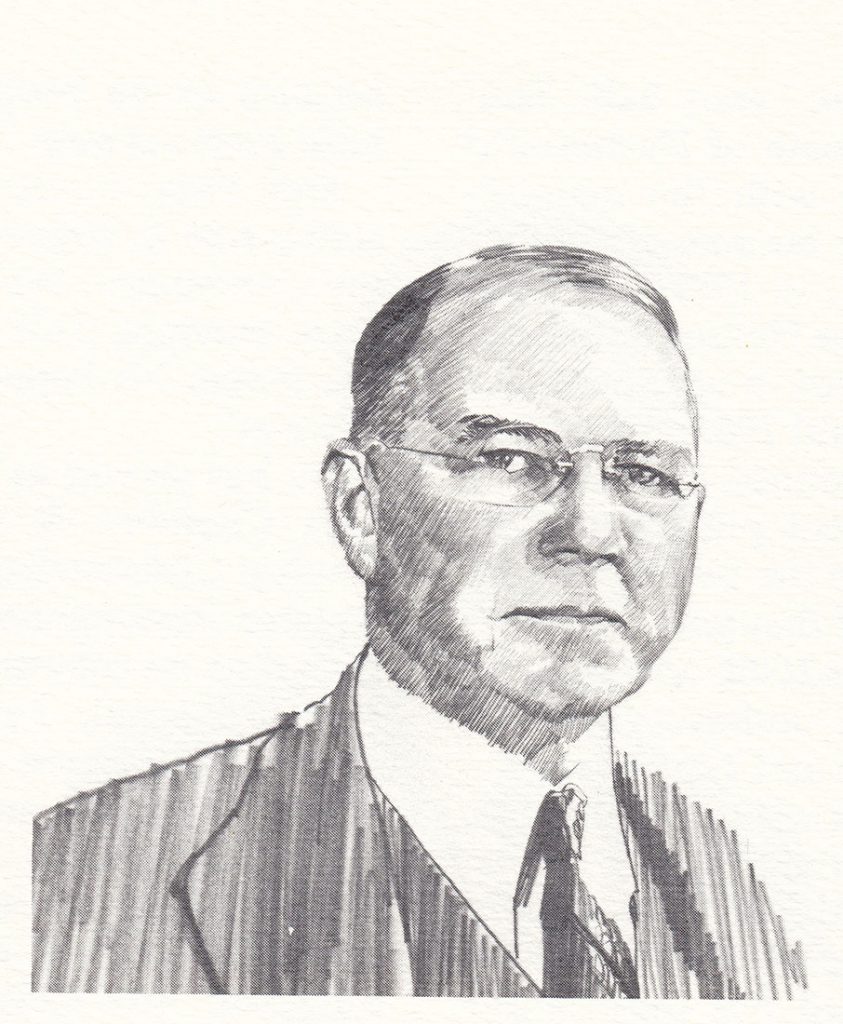The life and leadership of George Huguley Lanier would occupy many pages of a history of the growth of West Point Pepperell, Inc. – from the original cotton mill incorporated by West Point Manufacturing Company at Langdale, Alabama, in 1880 into the modern textile giant ranked 251 in the 1985 Fortune 500, with sales of $1.3 billion.
From 1906 until 1948, George H. Lanier led West Point Manufacturing Company through two world wars, three major depressions, some trying recessions, and near resolutions in both sociology and technology. Under his leadership, West Point Manufacturing Company grew from four cotton mills with net sales of $2.5 million in 1910 to nine manufacturing and four support facilities with net sales of over $100 million in 1947.
“Mr. George,” as he was known to thousands of his fellow employees pioneered many changes for the betterment of employees because he believed that “the plants could truly profit only as the people truly prospered.”
George Huguley Lanier was born in West Point, Georgia, on August 22, 1880, the elder son of LaFayette and Ada Alice Huguley Lanier. After having served as an apprentice in the (Chattahoochee) Valley mills in Alabama and following his graduation from the Philadelphia Textile Institute in 1900, George Lanier served for five years as superintendent of the Pepperton Cotton Mills in Jackson, Georgia. While there, he married Marie Lamar of Americus, Georgia. They became the parents of five children: Joseph Lamar Lanier, George Huguley Lanier, Jr., Bruce N. Lanier, Marie Lanier (Jennings), and Lucy Lanier (Nixon).
In 1906, George Lanier’s father, who had been the prime factor in the organization of West Point Manufacturing Company and was then its president was ill. The Boston interests of the company prevailed upon the young man who had proven his worth in Jackson to return to Alabama as vice president and general manager of the Company. From 1906 until 1925 when George Lanier was made president, he was entrusted with all but the title of the full management of the company.
Under his leadership, additional units of West Point Manufacturing Company were built at Shawmut and Fairfax. The West Point Utilization Company, the Service Division, and the Research Division were organized and put into operation. Dixie Cotton. Mills, LaGrange, Georgia; Equinox Mill, Anderson, South Carolina; and Cabin Crafts Inc., Dalton, Georgia, became subsidiaries. In 1945, the company acquired Wellington Sears Company, a selling agency in Boston, and in 1947, Columbus (Georgia) Manufacturing Company. By 1948, West Point Manufacturing Company had become one of the top ten textile manufacturing corporations in America, its products being sold in every state and in 19 foreign countries.
As West Point Manufacturing Company prospered, so did the employees and people of the Valley. George Lanier became a leader in the improvement of their health, education, and welfare.
“Mr. George” launched a health program in the mills and villages. Visiting nurses were employed to supervise the first aid rooms in the mills, see the injured and visit the homes of the employees to attend to the sick members of their families.
He had labor crews to keep the villages clean. He enlarged educational and religious facilities, constructed modern school buildings; and supplemented the pay of teachers. Night schools were established for those who wanted to further their education. Public libraries, gymnasiums, auditoriums, and playgrounds were built. The day nursery, started by his father, was expanded into a kindergarten system in each of the communities where the Company had operations.
In 1942, he was instrumental in establishing the Chattahoochee Valley Hospital Society, and because of his work, a hospital at Langdale, Alabama (named the George H. Lanier Memorial Hospital in his honor) was the first project in the nation to receive a grant under the Hill-Burton Act. The Society broke ground for the building on April 18, 1948 (only five months before George Lanier’s death), and the first patient was admitted on January 18, 1950.
George Lanier’s leadership in business and civic affairs extended beyond his beloved Valley. For example, he was a director of major professional organizations, such as Cotton Textile Institute, Cotton Duck Association, American Cotton Manufacturers Association, the Cotton Manufacturers Associations of Georgia and Alabama, and Textile Hall, Greenville, South Carolina.
He was elected to serve as a member of the Alabama State Department of Education; as a director of the Alabama Department of Public Welfare; as a trustee for the Alabama School for the Deaf and Blind, and the Darlington School for Boys at Rome, Georgia. He was also a member of the Alabama Board of Industrial Relations Committee, the State Advisory Council of the Alabama Unemployment Compensation Commission, and the Advisory Board of the Alabama State Docks Commission.
George Lanier was not only vice president and director of the First National Bank of West Point but also a director of the First National Bank of Atlanta and the Trust Company of Georgia, and of the Atlanta and West Point Railroad Company and the Western Railway of Alabama.
George Huguley Lanier died on September 17, 1948. Continuing the policies of his father, George Lanier had, as President of West Point Manufacturing Company, devoted himself untiringly to the further development of “The Valley” – concentrating on improving the living and working conditions of the mill employees; on beautifying the villages; and on improving the educational opportunities of the people.
Magnanimous of heart, “Mr. George” had personally donated land on which a scout camp was built at Pine Mountain and a lot in West Point for the home of the Girl Scout Little House. He had helped many young men and women in the Valley to be able to attend college. Deeply religious by nature, he was for many years a deacon of the First Christian Church of West Point.
In every way, “Mr. George” had exerted a tremendous influence over the economic, social, and cultural development of “The Valley.”
As stated in The West Point News (September 23, 1948):
Few men have endeared themselves so profoundly and so universally to the people of a community as Mr. Lanier. His gentle spirit, his magnanimous heart, his deep personal concern for the welfare of the employees of his companies, his unbounded generosity, and his quiet but effective leadership, made him public friend and first citizen of the Valley.
“The Valley,” in particular, and Alabama in general, benefited from the progressive and caring attitude of George Huguley Lanier.




